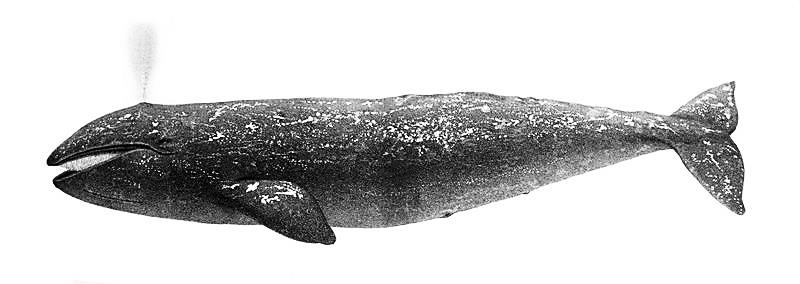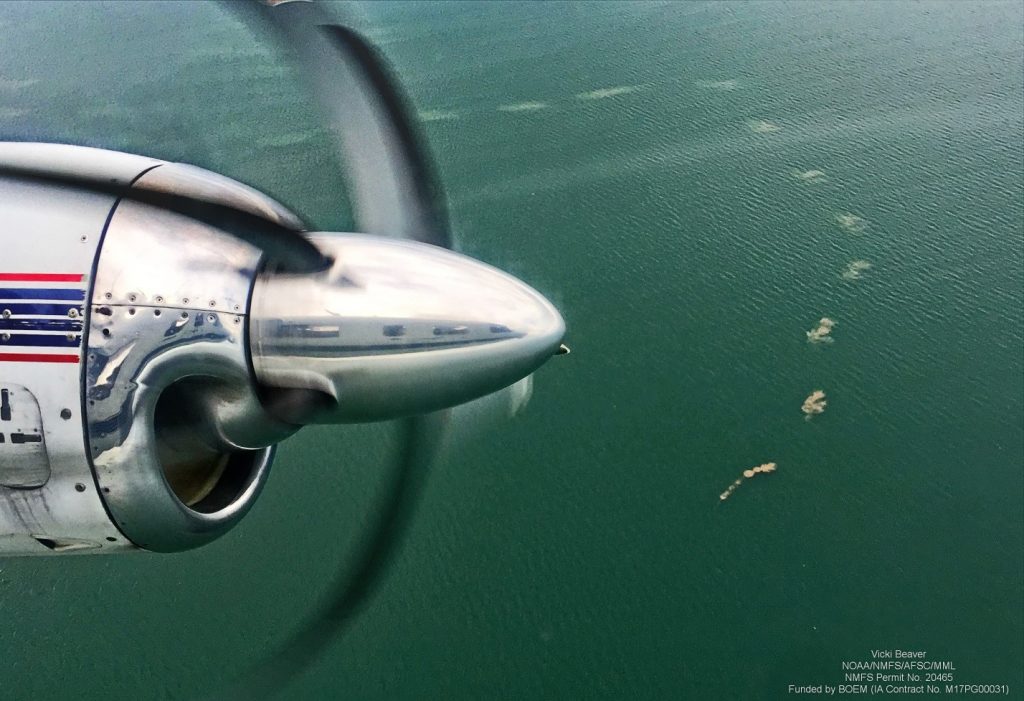by Robert D. Kenney

I know what you’re saying—“He’s really gone off the deep end now! There are no gray whales in the Atlantic.” That’s sort of true (take your pick about which part), but not entirely. In May of 2010 marine biologists conducting a survey off the coast of Israel sighted a whale that looked very strange, took some photographs, and were amazed when they looked closely at the photos later to realize that it was a gray whale. Three weeks later the same whale (recognized by matching the photos) was seen at the opposite end of the Mediterranean, off the coast of Spain. Another gray whale was spotted off the coast of Namibia in southwestern Africa in 2013. Comparing photographs again, scientists could see that it was a different animal than the one that had visited the Mediterranean. After lingering along the coast of Namibia for a month, the whale vanished. So we know that, during the 21st Century, at least two gray whales from the North Pacific have wandered into the Atlantic. Warming temperatures likely have made it easier for a whale from the North Pacific to transit the Northwest Passage through the Alaskan and Canadian Arctic into the North Atlantic. Once there, following a “normal” migratory route down the eastern side of the basin might naturally lead it to the Mediterranean or West Africa. Maybe we should expect that sort of thing more often in the future. What many people don’t realize, however, is that gray whales used to live in the North Atlantic—not really that long ago.
Gray whales occur only in the Northern Hemisphere, and today survive in two separate populations on the eastern and western sides of the North Pacific (the “California” and “Korean” stocks, respectively), primarily in waters relatively close to the shore. Gray whales undertake some of the longest migrations known for any mammal. California gray whales migrate between calving grounds near Baja California, Mexico and feeding grounds in the Bering, Chukchi, and western Beaufort Seas. The Korean population migrates between calving grounds in the South China Sea and feeding grounds in the Sea of Okhotsk. Very little is known of the distribution and migration of the former North Atlantic population. Subfossil remains have been found at scattered sites in northern Europe and along the east coast of the U.S. Given the coastal distribution of North Pacific gray whales, it seems reasonable to presume that North Atlantic gray whales were similarly coastal animals. Some scientists have speculated that early reports from the American colonies of whales using Delaware Bay as a calving ground, often presumed to have been right whales, may actually have represented North Atlantic gray whales.
The California gray whale stock was formerly classified as Endangered under the U.S. Endangered Species Act, but was removed from the list in 1994. It is classified as Least Concern on the IUCN Red List, with about 21,000 animals in the population. The Korean stock was believed to have been extirpated in the first half of the 20th Century, until it was revealed that 67 had been killed during 1948–1967 by Korean whalers. It is classified as Critically Endangered on the Red List. The most recently published estimate is that the population includes about 140 individuals (not including calves) and may be slowly increasing.
Gray whales were extirpated in the North Atlantic in early historical times, by the late 17th or 18th Century. They apparently persisted long enough to have been hunted by early whalers on both sides of the basin. There are historical accounts of living gray whales from Iceland in the early 1600s and possibly off New England in the early 1700s, and suggestions that they survived near Iceland into the 18th Century. The youngest specimen from the eastern North Atlantic dates to 1655 ± 260 years. There have been two published records of gray whale bones discovered in our region—a mandible carbon-dated to the very early 18th Century (± 35 years) found in Southampton, New York in 1977, and another mandible dated to the 16th Century found in Toms River, New Jersey in 1855. If, in fact, whaling were the cause of their disappearance, North Atlantic gray whales would be the only whale population known to have been hunted to extinction by commercial whaling. It seems more probable, however, that any impact of whaling was relatively minor and that they were rare and on the verge of extinction on their own.
In 2005, two British scientists presented a proposal to a meeting of the Society for Conservation Biology. Their idea was to airlift 50 California gray whales from the Pacific to the North Atlantic off the British Isles and re-establish a North Atlantic population. They believed that the project would enhance a British whale-watching industry without any potential risk to fisheries given gray whale feeding preferences. So far the project has not advanced any further than the pipe dream phase.
An aside for the nomenclature nerds: For many years North Pacific gray whales were known to science as Rhachianectes glaucus, a name published by Edward Drinker Cope in 1868. When it became clear in the early 20th Century that North Atlantic and North Pacific gray whales were the same species, the name Eschrichtius gibbosus, published by Johan Christian Polycarp Erxleben in 1777, was applied, since the oldest published name has priority under the rules. At one time it was believed that Erxleben had based his name on the “scrag whale” listed in a paper in 1725 by Paul Dudley, an early Massachusetts naturalist (and later both Attorney General and Chief Justice of the state supreme court). Dudley had written about the kinds of whales hunted by New England whalers, and his description of the scrag whale does seem to fit the gray whale rather well. However, a simple description has no nomenclatural authority, and Erxleben actually listed Dudley’s whale as “Species obscurae.” Erxleben’s name is considered a “nomen dubium” (doubtful name) because there was no designated type specimen or reference to any other publication. In 1861 Wilhelm Lilljeborg had described Balaenoptera robusta from subfossil skeletal material found in Sweden, but presumed that the bones were from an extinct fin whale relative. Once it was clear that the bones were from a gray whale, Lilljeborg’s name had priority over Cope’s because it was published seven years earlier. However, the modern consensus is that the gray whale belongs in a different genus (and family) than the fin whale. Erxleben was the first to publish a different generic name, and the specific and generic names have to match in gender, so today the gray whale’s accepted scientific name is Eschrichtius robustus. The bottom line is that the name of a whale species currently found only in the North Pacific is based on some old, originally mis-identified bones from the North Atlantic, where the population is extinct (and was already when the description was published).
Description: A gray whale is more robust in form than a fin whale, but less so than a humpback or right whale. Calves are born at 4.6–5 m, and adults reach 11–15 m. The head is relatively short, with a moderately curved and tapered rostrum. There is no dorsal fin; there is merely a low hump followed by a series of “knuckles” going back to the tail. There are 2–5 short, deep creases on the ventral surface in the throat region, which allow for quick expansion and suction during feeding (see below). The flippers are relatively broad and tapered to points. The color of the body is gray to brownish gray, lighter in adults and darker in calves, with extensive irregular mottling and patches of barnacles and whale lice. If there was a beauty contest for baleen whales, gray whales would surely finish in last place. There are 130–180 short, yellowish baleen plates on each side of the mouth, with very coarse fringes.
Natural history: Gray whales are primarily benthic feeders, specializing on ampeliscid amphipods—small (half-inch) shrimp-like crustaceans that live in dense mats of tubes in the sediment. A foraging gray whale swims to the bottom; rolls onto its side; and sucks up a mouthful of sediment, water, amphipods, and their tubes; then forces a cloud of muddy water back out through the baleen filter. (If amphipods produced movies, their version of Godzilla rampaging through their city would probably look a lot like a gray whale). Gray whale feeding leaves behind a sea floor pocked with 1-meter by 2-meter oval pits. Interestingly, areas of Block Island Sound are known to have dense populations of ampeliscid amphipods, and one might speculate that it was historically a gray whale feeding ground—the Southhampton bone came from not very far away. Gray whales also can feed on prey up in the water column (like a fin whale—see installment 9 in this series, including krill, small schooling fishes, and squid, with a total of over 80 prey species recorded).

While it is true that gray whales do not eat commercially important fish species, one would still need to look closely at any proposal to re-establish gray whales in Rhode Island waters for possible impacts on fisheries. The same benthic amphipods that gray whales eat are important food sources for some fish species, especially flounders.
The reproductive biology of the gray whale is typical of baleen whales in general. Females mature at 5–11 years of age, the gestation period is about 13 months, calving and mating occur in winter, and calves are weaned in about 7 or 8 months. The typical inter-birth interval is about 2 years.
Coming next in Marine Mammals of Rhode Island: Gray seal
Pingback: – Marine Mammals of Rhode Island, Part 13, Gray Whale